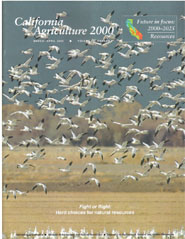All Issues

Fight or flight: Hard choices for natural resources
Cover:
Snow geese forage in a harvested corn field in the Sacramento Delta. While swelling numbers of these birds are a problem in the Midwest and the Canadian Arctic, snow geese are stable in California. At one time, they were in serious decline.
The Central Valley is the most important winter stopover along the Pacific Flyway for millions of birds. The struggle to preserve natural resources such as water, land, and wildlife while maintaining a strong agricultural economy, will require Californians to make difficult choices in the future. Will we fight to strike a balance, or allow our resources to slip away?Cover photo by B. Moose Peterson/WRP.
March-April 2000
Volume 54, Number 2
Volume 54, Number 2





